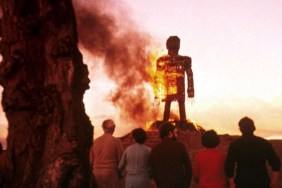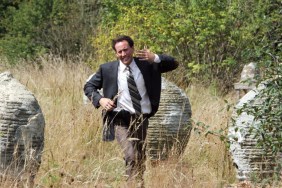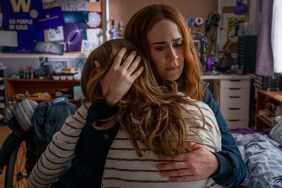Interviews with Hardy, his cast & photos

“What most people don’t realize is that when British Lion Films was sold out from under [the leadership of] Peter Snell, my film, The Wicker Man, was buried,” begins writer-director Robin Hardy, who is hard at work on its long-awaited sequel, The Wicker Tree, shooting outside of Edinburgh in Scotland.
“It was a classic show business ploy for tax purposes, and my gut instinct was to distribute the film in the United States. So I contacted Roger Corman, who was enthusiastic, but he wasn’t offering the $300,000 that [the consortium] could get as a tax shelter if they just dumped it. Soon after, Cinefantastique came out with 37 pages of photos, calling it the ‘Citizen Kane of horror films.’ A group at Tulane University in New Orleans decided to adopt The Wicker Man as a project, raising $5-6 million, and Christopher Lee offered to come to the United States and work with me on publicity. We went to film festivals all over the country, bicycling the print from city to city, getting ‘boffo’ kudos from Variety and other critics while, in London, those businessmen were still trying to bury it and discredit me and Peter Snell.”
Eventually, The Wicker Man became a cult classic, but its nasty, confrontational history still rankles Hardy, who openly admits that he’s partly motivated by revenge.
“Factoring in also is that Shepperton Studios lost the original negative, at least that’s what they said. No one really believed that and, through various circuitous channels with the help of the original editor, we were able to obtain 93% of it. Then dear Roger Corman came through for us. He’d kept the print we’d sent him and he’d only screened it once. So, frame-by-frame, we were able to restore the seven minutes that had been lost. That’s what’s in the Director’s Cut DVD, which was released only about eight years ago. All-in-all, I only made 5,000 (British) pounds from The Wicker Man and I don’t think Christopher Lee was ever paid.”
About The Wicker Man remake starring Nicolas Cage, Hardy is openly disdainful, noting, “It was a complete failure. There was nothing enchanting. No fun. They just didn’t get it. There was that pointless transfer of male to female; the music is Muzak, elevator music; and Cage makes a complete fool of himself. Christopher Lee told me that, after the film tanked, Cage happened to meet him in Hungary and he told Lee that they had no idea what went wrong. Frankly, I think [writer] Tony Shaffer cursed them, like the remake of Sleuth, which was an awful, dreadful film.”
Since 1973, Robin Hardy has been involved in many corporate ventures, along with writing books and designing historical theme parks: “My life has not been empty without making films.” He has eight children and has lost three out of five wives to cancer. For the past 10 years, he’s been married to a French Canadian, Victoria Webster, and they maintain homes in Somerset (UK), Corsica (France), Quebec (Canada), along with a flat in London. Since a Vermont family farm, now belonging to his children, is only an hour’s drive from their place across the border in Canada, he visits the USA often.

Yet for nine years, in the back of his mind “a spiritual sequel” has been lurking.
“Right now, the horror film genre is in a complete rut,” he asserts. “People are looking for something different, and the thriller film fantastique is based on the idea that you can incorporate ordinary life – songs, music, humor – where, underneath, something sinister lurks. [German filmmaker] Leni Riefenstahl disguised the horror of the Third Reich in Triumph of the Will (1934), which was commissioned by Hitler to document the Nuremberg Party rally. And we’re doing the same kind of thing again in this new film.”
In The Wicker Tree, Beth is a successful pop music singer and devout member of the “Cowboys for Christ” Protestant church in Texas. She and her fiancé Steve, who wear silver “purity” rings, are dedicating a year of their lives to missionary work among the “heathens” in the small village of Tressock in the lowlands of Scotland. After performing a concert at a local cathedral there, they are befriended by Laird (Lord) Lachlan and his wife Delia, who invite them to join the May Day celebration. Lovely Beth becomes Queen of the May, while Steve is honored as the best-looking, cleverest young man around, known the Laddie. What they don’t realize is that they’ve agreed to become an integral part of a pagan rite worshipping the ancient Celtic goddess Sulis.
“In this film, I want to show how sympathetic characters can unwittingly be drawn into a seemingly friendly, hospitable community in which something frightful is going on underneath the surface. That’s what happened in Germany, of course. They’d all read ‘Mein Kampf,’ yet no one acknowledged what was really going on. Like Hitler, Sir Lachlan Morrison is a dictator with charm and charisma. In this case, there’s religious elitism as well as social elitism.”
And Robin Hardy knows his subject matter well, having written “Cowboys for Christ,” which was published in the UK.
“There’s a real Cowboys for Christ church outside of Fort Worth, Texas. I visited and listened to what was going on. It was flamboyant and, therefore, fascinating, given that in Britain there’s a strong animosity to evangelism. Brits don’t talk about their faith; it’s a taboo. In translating the novel to a screenplay, I gave back stories to each of the characters, as one would, and the two young Americans are portrayed as very sympathetic but, basically, the plotline is the same, as much as possible.”

After coaxing British Lion chairman and CEO Peter Snell out of retirement to become his producer, Hardy and Snell joined forces with Peter Watson-Wood and his partner, Alastair Gourlay, to bring The Wicker Tree to the screen for a tight $3 million budget. Last year, Hardy shot some exteriors in Texas and had preliminary talks with Christopher Lee and Joan Collins. Then Lee developed back problems when he tripped over a cable on a movie set in Mexico, leaving him unable to tackle the physically demanding role of Lachlan, and Joan Collins made other plans for this summer.
So Hardy chose Scottish actor Graham McTavish (Rambo) who says, “I feel in some ways, a great responsibility to Christopher Lee, to Robin and to the legacy of The Wicker Man. As someone who was inspired by that film, it’s tremendously exciting and challenging to fill the shoes of Christopher Lee – and I only hope I can do it. For an actor, Lachlan is a role you seize with both hands.”
Christopher Lee fans should note, however, that he is planning to appear in The Wicker Tree in a pivotal and instantly recognizable supporting role. And Jacqueline Leonard is Lachlan’s inscrutable wife Delia.
As the twentysomething Americans, Beth and Steve, Hardy cast Brittania Nichol and Henry Garrett.
“My early life in South Carolina was somewhat similar to Beth’s,” muses Brittania, whose aunt (Leslie Nichol) was in the London stage version of “Mamma Mia” and introduced her to musical theater: “I was raised in a very religious household of non-denominational Christians, very close to Baptist. When I read the script, I immediately felt, ‘I know this girl.’ I loved The Wicker Man and my father, who is English, had a major crush on Britt Ekland, so I’m very happy to be a part of Robin’s vision.”
“I can really relate to Steve,” adds Henry. “My mother is from Bristol and lives in Ghana, South Africa, and my father’s family is Dutch. His parents settled in Texas, so I know the territory well. The script is awesome and our staying in Dalhousie Castle in Scotland makes it all seem very real. This morning, I took a run through the forest, pretending I was being chased like the Laddie.”
As uninhibited, seductive Lolly (think of Britt Eckland in The Wicker Man), Hardy picked Honeysuckle Weeks, best known as Samantha Stewart on TV’s “Foyle’s War.”
“This is a very different role for me,” Honeysuckle confesses. “My characters up to this point have been very repressed, barely been kissed. I’ve played a vicar’s daughter for the past eight years, so being Lolly, a child of nature, is a chance to let it all hang out.” (As for her unusual name, she explains the scent of honeysuckle was strong at the time of her birth.)

Scottish actor Clive Russell is Lachlan’s loyal servant, Beame, whose specialty is taxidermy: “As it happens, in Clive Barker’s Book of Blood, my job was to skin people. But in The Wicker Tree, Beame is not an overt menace. He’s simply trying to be a good butler to Sir Lachlan and his wife. For him, skinning people is like peeling a peach, and there’s something quite delightful about the ordinariness of the villagers, as opposed to the macabre undercurrents.”
And for motivational speaker/hypnotist/author/actor James Mapes, the role the Cowboys for Christ church’s tap-dancing, guitar-strumming, mandolin-playing Reverend Moriarty presents “the biggest challenge I’ve ever had and the greatest adventure.” (James Mapes is my husband, which is why I was in Scotland.)
“What most people don’t realize is that there are 30 pieces of music in The Wicker Tree and they’re integral, propelling the story,” notes Robin Hardy. “Keith Easdale, who’s from Glasgow and lives in Italy, has composed 23 vocal numbers and six or seven town band numbers, plus four incidental pieces. They’re part pagan/part Christian with lyrics taken from the great Scottish poet Robert Burns, Shakespeare, T.S. Eliot and the like. When Beth is in the cathedral in Scotland, she’s singing a bluegrassy version of ‘The Magnificat’ and the final song is kind of like ABBA’s ‘I Believe in Angels.’ It’s always been interesting to me how important music is in Judeo-Christian services. But the Islamic religion doesn’t have that; perhaps the Prophet just wasn’t into music.”
Rich in Scottish history, various locations form a unique backdrop for the plot, including the scenic 7,000-acre estate known as Arniston House, owned by descendants of the aristocratic Dundas family who were granted the lands near South Queensferry in the 1160s. Nearby is Dalhousie Castle, dating from the 13th century and inexorably linked with the history of the Ramsay family. The picturesque cathedral where Lachlan hears Beth sing is St. Mary’s Chapel, commissioned in 1843 for the private worship of the Duke of Dalkeith and his Duchess.

“I’ve never been into the film-making infra-structure,” Hardy admits. “What I write doesn’t come across on the page to the average studio executive. So much is in the visuality and the music. What I do breaks the rules. In Hollywood, by the end of the first act, something major must happen. In my scripts, it doesn’t. I like to slowly build dread and suspicion. It isn’t until the end of the second act that you’re certain that something awful is happening. You fear it – but you don’t know what ‘it’ is. It’s not like whodunit but what the ‘dunit’ is going to be. The final act is, as Shakespeare would say, ‘Horror on horror’s head,’ because ‘The Laddie is like a sacrament â the body â the blood.’ As for Beth, another fate awaits her.”
At age 80, Robin Hardy shows no signs of slowing down: “I don’t feel my age particularly. I’ve got several more projects I’m working on, including a third part of the pagan trilogy, ‘The Twilight of the Gods,’ set in Iceland, reaching back to Wagner’s Ring Cycle. The Scandinavians had no written language when they landed in Iceland but they had a great oral tradition, great sagas, and that’s what inspires this, as the country of Iceland becomes a giant theme park under the aegis of a studio like Disney or Universal.”
“It’s not difficult for a conglomerate to take over a land of 300,000 people. Problem is: the Nordic gods don’t like the trivialization of their traditions and people start disappearing,” he continues. “The news is suppressed, of course, and all is denied, just like with the Iraq War, and the studio basically doesn’t care. But Icelanders, even the best educated, believe in fairies, and that fantasy is an extra dimension. You know how – in Wagner – the Rhine River rises and engulfs the stage? In Iceland, there’s a volcano that’s covered by a glacier. Occasionally, it melts on the underside. Basic geology. Huge geysers come up and water engulfs the countryside and the gods get the last word. Like so much, it’s based on truth.”
For a behind-the-scenes photo gallery by Susan Granger, click here!





Source: Susan Granger, Photos: Graeme Hunter









